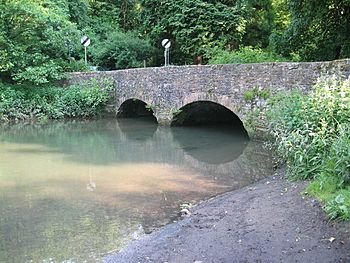Mells River facts for kids
Quick facts for kids Mells River |
|
|---|---|

Bridge over the Mells River at Great Elm
|
|
| Country | England |
| County | Somerset |
| Cities | Gurney Slade, Mells, Great Elm, Frome |
| Physical characteristics | |
| Main source | Somerset, England 2 m (6 ft 7 in) |
| River mouth | River Frome Frome, Somerset, England 51°14′50″N 2°19′14″W / 51.24722°N 2.32056°W |
| Basin features | |
| Tributaries |
|
The Mells River is a small but interesting river in Somerset, England. It starts its journey in the Mendip Hills near Gurney Slade. From there, it flows eastwards until it joins the River Frome in the town of Frome.
This river is important for the local area. It has played a role in history and is home to special wildlife.
Contents
About the Mells River
The Mells River flows through a beautiful part of Somerset. It helps shape the landscape as it makes its way to the River Frome. The river is quite short, but it passes through several interesting places.
Where the River Flows
As the Mells River flows, it forms one of the edges of Mells Park. This is a large estate with a historic country house in the village of Mells.
A few kilometers further downstream, the river flows between two very old forts. These forts are called Wadbury Camp and Tedbury Camp. They were built even before the Romans came to Britain! The river also passes through the western part of the Harridge Woods nature reserve. This is a protected area for plants and animals.
History and Industry
The Mells River was once very important for local industries. Its flowing water provided power for mills and factories. In 1744, a man named James Fussell III set up the Old Ironstone Works here. The river's power helped these works and other mills to operate.
Today, a small part of the river, about 0.25 hectares, is a special protected area. It's called a Site of Special Scientific Interest. This is because it's a vital home for two types of bats: the Greater horseshoe bat and the Lesser Horseshoe Bat. These bats are rare, and the river area provides them with a safe place to live.
Bridges and Canals
Several old structures cross or interact with the Mells River. One of these is the Vobster Inn Bridge. This bridge carries a lane over the river and was built in 1764. It is considered a historic building.
At Great Elm, you can find the Murtry Aqueduct. This aqueduct was built around 1795. It was designed to carry the Dorset and Somerset Canal over the Mells River. Aqueducts are like bridges that carry water, allowing canals to cross valleys or rivers.
Underground Secrets
The Mells River has some fascinating geological features. Water from Whatley Quarry flows into the river. Downstream from this point, there's a unique spot called the Mells River Sink.
This "sink" acts in two ways. When there's a lot of rain and the water level is high, it acts like a spring, with water flowing out. But when the water level is low, it acts as a sink. This means river water disappears into underground passages within the Limestone rock.
Scientists have used special dyes to trace this underground water. They found that a part of the river flows underground for about 2.5 kilometers (1.5 miles).
Archaeological digs near the river have also uncovered amazing discoveries. They found bones from a woolly rhinoceros, which lived thousands of years ago. They also found a bronze brooch from the 1st century, showing that people lived and used this area a very long time ago.

